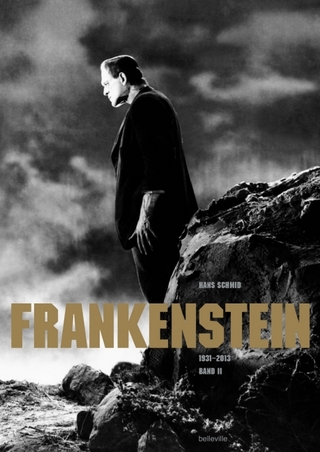
Special Makeup Effects for Stage and Screen
Routledge (Verlag)
978-1-138-04903-1 (ISBN)
- Titel erscheint in neuer Auflage
- Artikel merken
A companion website contains artist profiles that showcase some of the world’s top makeup effects artists, including Steve Wang, Ve Neill, Matthew W. Mungle, Miles Teves, Jordu Schell, and many others. Also included are detailed makeup tutorials led by experts in the field, such as Maddie Singer and Toby Sells.
Todd Debreceni is a special makeup effects artist who has worked for Disney, Warner Bros., 20th Century Fox, and TBS, and is the owner of BaPoFX makeup effects. He is a recipient of a Los Angeles Drama Critics Circle Award, and has received two Ovation Awards, a True West Award, and a Henry Award for Special Accomplishment in Makeup Effects. Todd has worked in film, television, and theatre around the world for more than 30 years, and his background in orthopedics and reconstructive plastic surgery have made his transition into prosthetic makeup creation a natural evolution. At BaPoFX, Todd specializes in prosthetic makeup design, fabrication, and application. He continues to teach college courses in cinematography, acting, sculpture, makeup design, and visual effects in Denver, CO, which he has done for almost 20 years.
Foreword
Acknowledgments
A Special Note About the Companion Website
Preface
Chapter 1 – The Industry
Key Points
Introduction
Stage vs. Screen
Contributions from Medicine
The Workspace
Safety and Health
Professionalism
Your Portfolio
Your Kit
Chapter Summary
Notes
Chapter 2 – Anatomy and Design
Key Points
Introduction
Using the Computer
Elements of the Design
Body Types
The Human Body
The Skeletal System
The Skeleto-Muscular System
The Head and Neck
The Face
The Torso and Upper Limbs
The Abdomen and Lower Limbs
Surface Anatomy
The Eyes, Ears, and Nose
The Ears
The Mouth
The Skin
Stretch Marks
Age Spots
Freckles and Moles
Varicose Veins and Spider Veins
Birthmarks
Hair
Scars
Symmetry and Proportion
Anatomical Planes
Facial Ratios and Phi
Ratios and Body Proportions
Geometric Analysis
Distinctions of Gender, Age, and Ancestry
Distinctions of Gender
Distinctions of Age
Facial Aging
Distinctions of Ancestry
Chapter Summary
Notes
Chapter 3 – Lifecasting
Key Points
Introduction
Safety Risks
The Materials
Alginate
Silicone
The Lifecasting Process
Overview
Teeth
Face and Neck
Casting a Positive
Bust: Head and Shoulders
Hands, Arms, Legs, Feet, and Ears
Hands and Arms
Legs and Feet
Ears
Full Body
Full Body: Prone
Full Body: Standing
Tips and Suggestions
Lifecasting with Silicone
Chapter Summary
Chapter 4 – Sculpting the Makeup
Key Points
Introduction
Materials
Preparing the Positive
Tools
Clay
Sulfur Clay
WED Clay
Oil Clay
Reference Photos
Teeth
Materials
Sculpting the Face
Blocking the Sculpture
Refining the Sculpture
Sculpting the Face, Head, and Neck
Blocking the Full-Head Sculpture
Sculpting Hands
Blocking the Hand Sculpture
Sculpting the Ears
Blocking the Sculpture
Chapter Summary
Notes
Chapter 5 – Breaking Down the Sculpture
Key Points
Introduction
Tools and Materials
Release Agents and Sealers
Making the Negative Mold
Keys, Flashing, and Cutting Edges
Building the Dividing Wall
Building a Different Style of Dividing Wall
Stone (Gypsum) Molds
Other Types of Molds
Silicone Rubber Molds
Matrix Molds/Jacket Molds
Fiberglass Molds
Fillers
Resin Molds
Epoxy Molds
Syntactic Dough
Urethane Molds
Chapter Summary
Endnotes
Chapter 6 – Casting the Appliances
Key Points
Introduction
Silicone: Platinum and Tin
Coloration
Color Theory
Materials
De-Airing/Degassing Silicone
Gel-Filled Silicone Appliances
Filling the Mold
Injection Filling
Hand Filling
Removing the Appliance
Conforming Molds
Foam Latex
Quirks
Running Foam Latex
Prepping the Mold
Filling the mold
Heat-Curing Foam
Removing the Appliance
Cold Foam (Urethane)
Materials
Quirks
Prepping the Mold
Filling the Mold
Removing the Appliance
Gelatin and Foamed Gelatin
Materials
Quirks
Making Foamed Gelatin
Filling the Mold
Removing the Appliance
Dental Acrylic
Materials
Filling the Mold and Removing the Appliance
Seaming Prosthetic Appliances
Seaming and Patching
Silicone
Foam Latex
Gelatin
Painting the Appliance
Silicone
Foam Latex
Gelatin and Cold Foam
Painting Teeth
Materials
Special Effects
Chapter Summary
Chapter 7 – Applying and Painting the Prosthetics
Key Points
Introduction
Skin Types
Adhesives
Application Techniques
Attaching the Appliance
Materials
Conforming Molds
Blending the Edges
Applying the Makeup
Foam Latex
Gelatin
Cold Foam
Silicone
Removing the Appliance
Materials
Removers
Technique
Skin Care
Cleaning and Storing the Appliance
Chapter Summary
Chapter 8 – Hair and Wigs
Key Points
Introduction
Types and Varieties of Hair
Tools and Materials for Postiche
Wigs
Weft Wigs
Knotted Wigs
Hair Attachment
Preparation for a Wig
How to Put on a Wig
How to Put on a Lace Wig
Beards, Mustaches, and Eyebrows
Laid-On Facial Hair
Crepe Wool (Hair)
Preparation
Application
Ventilating (Knotting) Hair
Preparation
Technique
Punching Hair
Technique
Technique (Eyelashes)
Chapter Summary
Notes
Chapter 9 – Animatronics
Key Points
Introduction
Technology
Mechanical
Servos
Additional Terminology
Motion Control
Electronic
DMX Controllers
Powering the Electronics
Structural
Surface
Operation
Chapter Summary
Endnotes
Chapter 10 – Other Makeup Effects
Key Points
Introduction
Resin Eyes
Bondo
Cap Material
Bald Caps
Making a Bald Cap
Applying a Bald Cap
Building up Ears and Nose
Tuplast
Nose and Scar Wax
Materials
Rigid Collodion
Stencils
Tattoos and Character/Creature Textures
Airbrush
Spatter and Stipple
3D prosthetic Transfers
Making 3D Transfers
Materials
Electrostatic Flocking
Wrinkle (Age) Stipple
Trauma, Wounds, and Bruises
Bruises
The Baseball Stitch
Nosebleed on Demand
Bladder Effects
Burns and Blisters
Burns
Blisters
Other Conditions
Skin Manifestations
Infected Veins
Skin-Safe Silicone and Gelatin
Chapter Summary
Chapter 11 – 3D Printing for Prosthetics and Animatronics
Key Points
Introduction
3D Printing Glossary
A Brief History
Uses
Who Uses 3D Printing?
The Design Process
Preparing the Model
Technology
Guidelines
SLA or SLS?
Operation
Application
The Future
Chapter Summary
Notes
Appendix A Your Kit
Appendix B Recipes
Appendix C Suppliers
Appendix D Conversion Charts
Appendix E Suggested Reading and Viewing
Glossary
Index
| Erscheinungsdatum | 12.09.2018 |
|---|---|
| Zusatzinfo | 1 Tables, color; 1103 Halftones, color; 1103 Illustrations, color |
| Verlagsort | London |
| Sprache | englisch |
| Maße | 178 x 254 mm |
| Gewicht | 1320 g |
| Themenwelt | Kunst / Musik / Theater ► Film / TV |
| Kunst / Musik / Theater ► Theater / Ballett | |
| ISBN-10 | 1-138-04903-4 / 1138049034 |
| ISBN-13 | 978-1-138-04903-1 / 9781138049031 |
| Zustand | Neuware |
| Informationen gemäß Produktsicherheitsverordnung (GPSR) | |
| Haben Sie eine Frage zum Produkt? |
aus dem Bereich



